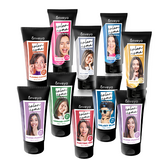Are you thinking of changing your hair color? Are you staying away from permanent hair colors that last longer and bring in the risk of damage? That’s your cue to turn to the world of crazy and funky temporary hair colors. Temporary hair colors, unlike permanent hair colors, are easy to apply and wash off. The convenience temporary hair colors have brought into a color fanatic’s life is truly amazing! Besides there's a wide variety of hair colors for men and hair colors for women available in the market, it’s so tempting!
Also Read : Temporary Hair Colors: Pros & Cons
Once you’ve made the decision to go for it, there are a few points you must know before you take the plunge! In this blog, we’re going to tell you about certain things you must know before and after using a temporary hair color! Let's get started!
On that note, why not check out the temporary hair color make up from Colorisma? They're 2 min hair colors coming in fabulous matte and metallic shades!
TEMPORARY WASH HAIR COLOR MAKEUP
• Temporary, commitment - free. Wash off with your next wash.
• Unlimited looks for any mood.
• 2 -minutes DIY color application.
• No bleach, no dye, no damage.
Things You Must Know Before Using a Temporary Hair Color
It is always better to do some research and understand what you’re going to put your hair through. While using a temporary hair color, you should find out how they behave the way they do and their basic nature.
Temporary hair colors wash out fast, as these are ammonia-free, and therefore only color the outer shaft of the hair. So, if you’re looking for a more permanent hair color change, this may not be the best hair color choice for you.
Also Read : 5 Reasons To Use Ammonia-Free Hair Colors
You might not get the exact hair dye shown on the pack! Do not assume that the color you get will be exactly the same as the color shown on the pack. Be it a bright red hair color, bold blue hair color, exotic blonde hair color or a classy grey hair color, what you see on the pack might not be what you actually get. The pictures on the coloring packs are mere illustrations and the actual results may be a lot different. Therefore, choose the hair color based on a shade scale of 1-10, where 1 is the darkest and 10 is the lightest. Also, before choosing a color, make sure it does not go against your skin tone, or else it will make your skin look dull and faded.
Don’t forget to protect your hairline, clothes, and home! Before coloring your hair, always remember to cover your clothes as well as the place to avoid stains. As for the hairline, it is recommended to cover your hairline with petroleum jelly.
Do a patch test as well as a strand test first! A patch test is necessary to make sure your scalp is not allergic to the hair dye. If, after the patch test, your skin experiences itching, redness, or swelling, discontinue use of the temporary hair color as it may have adverse effects on your scalp. A strand test is important so that you don't end up with a hair color you don't like!
Shampoo your hair before applying hair color. You should always wash your hair with shampoo before coloring it to get rid of any oils and greasiness on your scalp. After washing, make sure to dry it thoroughly so that the color can be evenly spread into your hair.
Things You Must Know After Using a Temporary Hair Color

Now that you've got the color you’ve always wanted, there are certain things you should know on maintaining the vibrant color and taking care of your locks.
- Do not shampoo newly colored hair. Temporary hair dyes do not last longer than a wash. Therefore, it is recommended to not shampoo newly colored hair if you want the color to last more than a day.
- Wash your hair until the water runs clear. When you’re getting rid of the color, wash thoroughly. This is necessary because if the color is still in your hair, it might end up staining your clothes, skin, and home.
- Do not wash your hair with hot water or blow dry your hair after using temporary hair colors. The heat from the blow drier and hot water will make your hair frizzy. Wash your hair with normal cool water.
- Resist the temptation to run your fingers through the colored hair strands. The color might stain your fingers when you touch it. So it’s better to let the color be.
- Use a color-boosting hair gloss. It will make your hair look shiny and give that fine salon-like glossy finish.
How Do I Prepare My Hair For Coloring?

‘Preparing your hair for coloring’ isn’t as difficult a task as it seems. To prepare your hair for coloring, all you need to do is wash your hair with shampoo to remove any oils or greasiness that may build up in your hair, and then dry your hair thoroughly. It is recommended to not use a hair dryer as it may lead to a frizzy mane, but the drier the hair is, the better the dye will soak in. ‘That’s it?’, you ask? Yes, that is all! Quite simple and easy, no?
Also Read : Hair Makeup: The World Of Temporary Hair Colors!
What Is The Best Way To Apply a Temporary Hair Color?
The best way to apply color to your hair is using your fingers. Be it highlights, soft balayages, lowlights or even money pieces, it is always better to apply the color to your hair with your own hands. This will help spread the color evenly throughout your natural hair color. Also, if you want to get a global hair color, we’d recommend you to start coloring from the roots.
Now that you know all about the ‘Must knows’ of temporary hair colors, it is your turn to go and color your hair wisely!
Disclaimer: All the content on anveya.com/blogs is solely for information. It is not intended to be a substitute for professional medical advice, diagnosis or treatment. Always seek the advice of your physician or a qualified health care provider. The information, suggestion or remedies mentioned on this site are provided without warranty of any kind, whether express or implied.




